December 28, 2025
On our way to our final destination, the city of Jaipur, we passed through some beautiful rural areas. This looks like a field of mustard, one of India's argricultural products.
We had time for a stop at Fatehpur Sikri, the capital of the Mughal Empire from 1571 to 1585 under Emperor Akbar. Fatehpur Sikri means "City of Victory." However, the city was completely abandoned in the early 17th century.
The East India Company took it over in the early 19th century and began some restoration projects. It was named a UNESCO World Heritage Site in 1986, which means it had additional funding for more restoration.
We were used to seeing cows roaming the streets in the big cities, and we had seen monkeys on the approach to the Taj Mahal, but this was our first experience with feral pigs foraging through the trash.
Apparently there has been a problem with locals ripping off the tourists. A sign near the entrance warns both English- and Hindi-speaking guests to beware of unauthorized tour guides and of vendors who will a) rip you off and/or b) relentlessly harrass you.
Another sign notes some of the things that cannot be brought onto the premises. Not allowed are fertilizer, toys, cigarettes, flags and banners, drones, flowers, lap tops, explosives, weapons, paints and pens, tools, alcohol, burning of religious books, flammable substances, flashlights, sweets and candy, helmets, and fruits and vegetables. I'm glad it didn't say no cell phones or cameras! They seem to be about the only things allowed inside the fortress.
Our first reaction was, "Oh yeah, more typical red brick structures."
This is the Diwan-i-Khas, or Hall of Private Audiences. It was here that Emperor Akbar held important meetings with religious leaders and scholars.
Check out this interesting structure inside. What was the inspiration? A bunch of bananas? An upside-down wedding cake? The four beams radiating from the center are catwalks. Akbar could stand up there--above everyone else both physically and symbolically--and easily move from one group of people standing below him to the next. Or he could place people of different religions or philosophies on each of the four catwalks and himself in the center circle, able to easily turn from one group to another while keeping them apart from each other. Ingenious.
With its elaborate carvings of patterns and symbols, the central pillar is a work of art all by itself.
We were impressed by the drainage channel that ran through the courtyard and by the carved stone window screens (although they sure ain't gonna keep out the skeeters).


Next to Diwan-i-Khas is the Treasury, three rooms that most likely held the imperial treasury of gold and silver coins
To me, this looks like two elephant heads attached to the pillars with their trunks reaching up to touch on the ceiling.
This building is the Panch Mahal (meaning "five-level palace"). It was commissioned by Emperor Akbar and includes design elements associated with Buddhist temples, such as columns rather than walls and an assymetrical structure with each level decreasing in size.
This place made us all feel like dancing!
The Anup Talao is a pavilion in the center of a large pool that was used as a stage for performers. Four bridges lead to the center, much like the catwalks in the Hall of Private Audiences. Some of the buildings surrounding the pool were for Akbar's harem.
The Hujra-i-Anup Talao (Turkish Sultana's House) is where some historians believe Akbar received visitors and honored guests. Others believe that since it is near the pool, it is where the queens hung out.
I have to keep reminding myself that this is stone, not wood.
Akbar's private quarters are close to the pool as well. He apparently liked the open structure we saw on other buildings. The water and the cross ventilation no doubt helped to keep things cool.
Here is a panoramic view of the pool and surrounding buildings:
Here is a panoramic view of the pool and surrounding buildings:
This is the gateway to the Jodha Bai Mahal, aka Empress Palace, home of Akbar's favorite wife and chief consort, Queen Mariam-uz-Zamani. She was the mother of Akbar's eldest surviving son who became his successor, Jahangir, and the grandmother of Shah Jahan, the man who built the Taj Mahal.
Inside the palace gate is a large, open courtyard.







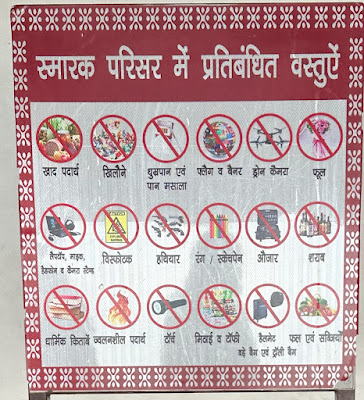












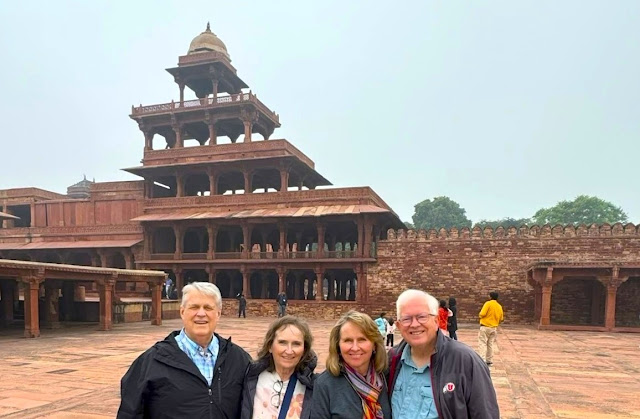






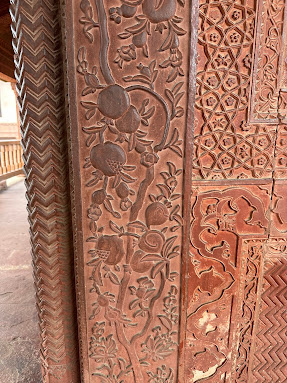




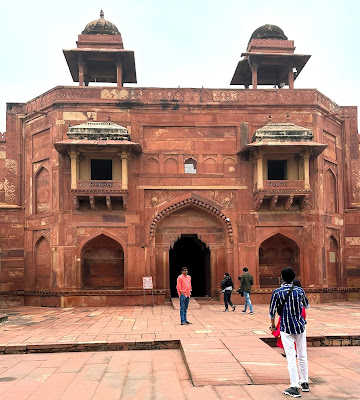





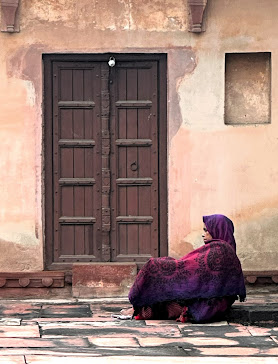
My favorite part was that it had a healthy population of rose-ringed parakeets among its buildings and walls. It seems like we had a fun discussion of how favoritism might be shown for a wife by her placement closer to or away from the pool, main activities, etc.
ReplyDelete